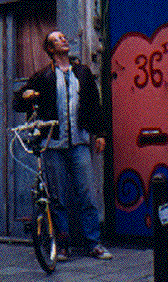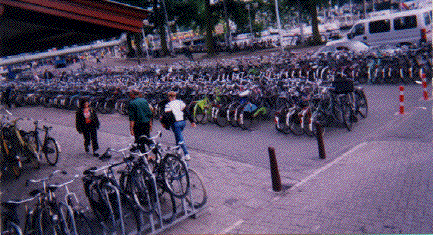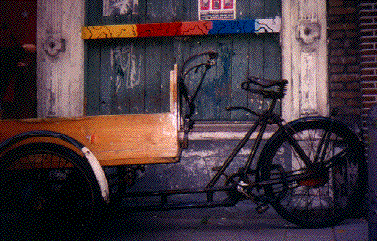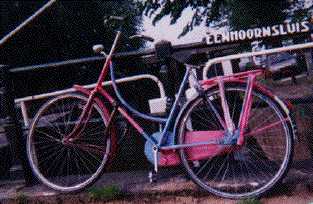 photo
by pete krebs
photo
by pete krebs
Hazel Tour: Bicycles
I brought along a handsome used $125 folding (to fit in the van, and to spite the airlines' criminal deterrents) Royce-Union bicycle. At each destination, it was the first thing unloaded and the last thing loaded in.
 photo
by pete krebs
photo
by pete krebs
Amsterdam
Emerging from the Central Station and 17 straight hours of advanced modern travel-torture, I can easily count 400 bicycles locked to racks along the front of the building. Every single one is a beat-up old, black - actually a few now appear to be owner-painted - upright one-speed. Around the corner of the building, 200 more, and back around the other end, another 200, and these are all at the Station's endless bike-racks. There are still another 200 in view parked higgledy-piggledy all over. A thousand bikes to welcome my one, returned to the lands of its manufacture.

OK, I'm mistaken, they are not all old, for here comes a mountain bike. In the course of our week in Amsterdam, I'll count a total of five (out of 10,000?) mountain bikes, two of which appear within seconds of this first one, ridden by the only 2 cops (gunless, of course - one a woman, the other with a pony-tail) we'll see in Holland. There are 50 times as many cheap folding bikes (like mine) as mountain bikes, and in a mad variety of models - mainly of German or Austrian manufacture, it seems like, and with English brand-names.
Brands that have folding-mechanisms identical to my Austrian-built Royce-Union's (a hinge on a swivel, tightened down with a fat nut) are: Arrow, Unis, Jumbo, Adriatic, and Superklasse.
Later, I'm told that the more valuable bikes are never left locked on the street. Theft is so prevalent a cyclist will use 2 or even 3 U-locks in addition to the stylish circular lock built-in behind the seat-post of almost every Dutch bike.
As I said, the vast majority of Dutch bikes are black and look at least 30 years old. The ones that aren't black are owner-painted. About one out of four bikes are what Americans call "girls' bikes", with a lowered top-tube presumably to accomodate skirts and dresses, and here referred to as granny bikes, the most noticeable differences being that the top-tubes are always an elegant circular arc, and it looks like as many boys ride them as girls.
The style of riding generally dictated by these black upright bikes you could call "the schoolteacher" - efficient, rhythmic, evenly paced, sitting up as in a straight-backed chair.
Quite close to the way I ride my adapted Royce-Union. Call me eccentric, but under professional supervision I've rigged up this little bike with a single handle-bar, extending the stem straight up to where it ends in a little tiller at chest-height. The tiller has a hand-brake for the front wheel, and there is another brake for the rear wheel right beside my left hip. It's a congenial choice for the narrow cobbled streets and sudden humped-up canal bridges of Amsterdam.
In all of Europe, it draws fewer looks than a day in downtown Seattle. (All the coming-up young intellectual-property robber-barons there will one day learn how to unbug their eyes.)
There are more mopeds than motorcycles here, and what there are of the latter are all quite low-cc.
Every so often is what must be a group bike-rental - swarms of tourists on bright yellow velocipedes.
There are frequently cyclists who sing as they ride, and this points up the immense qualitative difference in the larger picture: the virtual absence of competition with motor vehicles here.
My first trip to the Van Gogh Museum is deflected by a massive mob of tourists, so i turn into a side-street and find a kindergarten playground full of children playing with an amazing variety of unusual pre-bikes and kiddy-bikes - they start 'em young here.
The first work-bike ( it pushes a large cargo-box) I see is a recumbant (a low-slung seat with high pedals), but this is a rarity. The more usual work-bikes are infinitely more ruggedly-built than anything in the U.S., feature a great wooden box large enough to carry a washer & dryer, have a major emergency brake, and are marvellously maneuverable. I am fortunate to help our new friends Ramon and Eric deliver the modular-stage (!) to our performance-venue on a pair of "boxfiets", I think that's spelled right, pronounced "box-feets".
 photo
by pete krebs
photo
by pete krebs
Many, many great bicycle paint-jobs:
|
The recumbent boxfiet - turquoise with a black fender Gold and pink Purple, green and white Red with blue fenders Green fenders, pink rack and top tubes, yellow head tube, blue seat tubes Salmon-orange with blue scratches Bright yellow with 2"-wide horizontal black stripes Yellow-orange with pink spraypaint overtones Black with yellow fenders and stem-ring All purple, with flowers painted on Black,with copious purple feathers glued all over All pink, and I mean all: spokes, seat, tires - but blue pedals 6"-wide alternating yellow and black stripes Immaculate pure navy blue Immaculate pure ivory white Immaculate pure deep turquoise Immaculate pure dark red |
Maroon, blue, white - all in little splotches Cannondale (high-end mountain-bike), painted yellow very sloppily to look cheap and junky Very fine, expensive-looking road-bike painted immaculate pure light yellow Very, very weathered salmon-orange Green and gold camouflage with turquoise scratches Blue with yellow fish, and yellow with blue fish Red with white hearts in front; and from the seat-post back, the other way around Creamy yellow-white Immaculate pure dark purple Blue with pale-green rear fender Blue and green blotched on white: faux marble Black with gold dots Blue frame, yellow down(bottom)-tube, red fenders All dayglo: yellow fenders, orange stem/head-tube and down-tube, green seatpost and granny tube, red fully-enclosed chain-guard and rear skirt-guard - plus graffiti! Blue with red scratches and magenta fenders Red with dark-green scratches and pale-green fenders |
This wholesale painting of bicycles must represent the most wholesale autonomous citizen eradication of corporate advertising in the world.
Every 3 blocks in Amsterdam there is a canal. It's the Venice of the North - who knew? And the canals frequently feature canalbikes - a la Central Park Lake. On the third day, I have the most exciting experience of witnessing a collision between two of these vehicles.
Last but not least, in the park there's a Royce-Union folding bike, the twin of my own, that seals the connection between bikes and music: it has a large plastic dinosaur with Garfield attached, and a set of panniers holding on one side a big battery, and on the other an amplifier, from which extends a cable leading to a didjeridu with its butt sitting in a child's painted shoe, with Smurfs and a faux Cabbage-patch doll appended in turn to it, and a single bass-string running up its length, being played not altogether incompetently by a very small boy with a toy drum-stick - for alms.
Deutschland
Suddenly, at the hilltop university campus above Siegen - mountain bikes. 60% of the bikes chained up outside the student union are upscale mountain bikes - and not a one as old as 99% of Dutch bikes. There are 3 bikes pristinely painted in solid colors: violet, yellow, silver - no brands or decals remaining - awesome.
In Nuremburg there is a free weekly municipal bicycle-repair workshop in progress, directly adjoining the youth-club we are unloading our equipment into. Down the driveway is an elderly grey steel structure the size of a bus-shelter that looks like it's built out of cross-country skis. It's a bike-rack: you run your bike up a steep, lipped, ski, and lock it practically vertical.
This is where I see my very first ever cyclist with a cell-phone, and here is also the most meticulously-painted multicolor bicycle yet.
The monumental giant tragic squat we're to play at, Tacheles, is in East Berlin, which is so frantically being transformed by developers into West Berlin that all forms of transport are problematic. Three interesting bikes, though: one, a paint-job: deep dark red with short dark wavy stripes; then, a high-tech, completely-enclosed-by-white-plastic three-wheeler called a Twike; third, an otherwise unremarkable girls' bike with a child's seat cleverly detachable from the upper front of its top-tube.
Bremen, perhaps due to its proximity to Holland, has a ton of bikes, many of them older models. Here's a gossamer tall-bike so excellent I make a drawing of it. There's a trailer, home-made out of a pair of front-forks; a pretty, multi-color worm-squiggles paint-job; and a tandem, manufactured to accomodate a child in front, an adult in back. On the wavelength I guess, I find a huge bike-fair in progress at the central square, but note nothing unusual, barring the fact of the bike-fair itself and the exceptionally unusual square itself. Down to the river Weser, the signs directing one to the bike-path consist of tiny models of a old-style high-wheel penny-farthing. Way charming.
In Essen are the first helmets I've seen so far in Europe - the Dutch bike-cops didn't even wear them. Here is a bicycle rigged to push a wheel-chair. The NBA basketball game announced in hilarious German/English and broadcast live from Utah gets along without a network feed, so at half-time, instead of the usual lame interviews and car commercials, we can see what is actually happening at the arena in Salt Lake City: a crew of teen-age BMX-bike trick-riders showing off their energetic amateur stuff. (3 days later, the fledgeling Austrian break-dancing crew that follows our set, Nobody Rockz, exactly will remind me of these boys.)
Enger, our last engagement in Deutschland, is a wee village. Many Europeans ride in skirts or dresses, and you frequently see a simple treated-fabric or mesh cover over the top third of a bike's rear wheel and attached to the fender, to keep one's hem out of the spokes - a skirt-guard. And here is a lovely specimen of same, made of woven white elastic laces - very handsome.
Austria to Euskal Herria
Here in Linz is a small child on a tricycle which is attached to a long wooden handle held by her mom walking behind. And here is a young woman riding gracefully to an appointment - a cello slung across her back.
As in Amsterdam, Linz and Vienna are equipped with some old stone staircases with narrow channels running up (or down) next to them for bicycles. Is this civilization or what? Our Vienna night-club, called Flex, faces a canal, a hundred-foot wide, 5-mile-long city-center Danube-offshoot flanked by bikepaths and forbidden to motor vehicles except those making deliveries, i.e. our van full of music equipment and the little cars that service the 5 or 6 nearby open-air cafes or used-book stalls. Here, next to the pedestrian tunnel and stairs to street level, is a built-in obstacle-course for kids' bikes. A narrow path painted on the cement curls around on itself and through 15-foot-long painted cement tubes - on my very low bike, I still have to duck down - up onto painted cement 4-by-4's, through painted cement hoops, and ending suddenly at a finish-line consisting of the English word: APPLAUSE. The paint is old and eroding away.
Budapest immediately reminds me of Anchorage or Los Angeles: very few bikes, and you'd better ride on the sidewalk most of the time. Or you'll at the very least get doored a lot - lots of knee-injuries: the autos here are SMALL. Of the no more than ten bikes I see in all of Budapest, two carry riders in full racing get-up and three are the primitive and futile-looking rent-a-bikes in the care of a couple of pleasantly shady young men next to the funicular terminal beneath the Budavari Palota - the royal palace that contains the National Gallery.
On past Pecs and towards Croatia, in other words, through the Hungarian southwest, fully a quarter of the many rural and small-town bicycles are cheap folding-bikes, providing me with a cheap surreal thrill.
Some of these European borders are easier to cross than between some states. Anyway, suddenly we're in Slovenia, it's another lateral culture-switch, and Macbeth whispering to me: Is this a bike-lane that I see before me? Ljubljana is a serious cyclist's delight - I manage to forget myself amidst the stone byways and get really really lost.
Rome is even more incompatible with bicycles than Budapest (or Anchorage or L.A.), but with a startling exception. Even fewer bikes, even more dangerous traffic, much more treacherous curbs - 12 inches, sharp, and marble - but a prolific phantasmagoria of little scooters and lightweight motorbikes invites one to mimic their signature behavior and body-language - like sitting in a little straight-backed chair - and so pass for one of them, and safely into the peripheral vision of the incomprehensibly crazed Roman drivers. Needless to say, mountain bikes or road bikes, unless equipped with apehangers (high V-bars), don't lend themselves to this style of riding. Dutch bikes, high-handled cruisers, and especially my little one-handled bike, are all well-suited to riding here if you can handle the adrenalin. These drivers have faster reflexes than you can see.
Don't see a whole lot of bikes in Marseille, but then, all my time is going to applying patch after patch to one of my tires, after my rude American odor in a bike-shop compels them to sell me an obviously wrong replacement tube 5 minutes before closing. But the German crusty-punks lolling in the steep cobbled alley that fronts our club are agog at the unicorn Royce-Union once it's up and rolling.
Now here's the first gorgeous paint-job since Bremen - immaculate ivory-beige.
In the French countryside north of the central Pyranees - we are near Lourdes - next to the highway is a nothing-short-of-hallucinatory monumental tribute to the Tour de France in the form of a seven-story tall sculpture of a stylized racing-bike.
Monuments aside, southwestern France and Euskal Herria (NW Spain) is fanatical bike-racing country. Bike routes are marked with the blue circle, there is bike lane adjacent to the freeway, a preponderance of cyclists are in spandex, racing colors, helmets. And if proof were needed, we are tootling along a major rural 2-lane highway, when we come around a curve to be presented with this tableau: the road curves around in front of us, and we can clearly see some distance ahead a pair of cyclists riding abreast and sitting upright, apparently to converse, closely followed by 6 or 7 cars and a couple of semis, all obviously content to dawdle along at 15 MPH until a straightaway, when they can pass. No one honks, and the riders feel no obligation at all to scoot over for a few seconds to let the vehicles pass. (On hearing this retold months later, my dearest cousin Jacques, no stranger to the region, points out the obvious - that the drivers in question can be assumed to be cyclists themselves.)
At the spectacular beach in Plentzia are 20 small semi-circular blue & white bike-racks.
In Gorliz, an adorable patch-kit for 195 pesetas ($1.50).
In stone Elorrio, a beautiful Olmo road-bike in the window of a closed and dusty stone bike-shop.
In Bilbo (Bilbao), a great and perfect tromp l'oeil mural featuring a life-sized bicycle hung with a grocery bag, leaning against and casting a shadow upon the wall itself.
On the way back across to France on the highway, a cyclist on a hefty cruiser overtakes us on the right on a downgrade, passes into the lane in front of us, then signals with his left leg to indicate his intended turn, glancing back at us to see that we see.
Holland, Belgium, Holland
Painted bikes in Groningen (ancient northern university city, provincial capital, canal nexus, German-tourist mecca):
|
Black, with yellow fenders Pink in front, turquoise in back Blue, with gold fenders Lime green Royal blue, with a lime-green front fender Red with white daisies Red with black joints and trim Pink with silver asterisks Yellow, with salmon fenders |
White, with brown cow-spots Black with white Jackson Pollock squiggles Purple, with a light blue-green front fork and rear fender, and cream-yellow front fender Completely covered with VERA (the name of this evening's rock-venue) stickers White with tiny orange polka-dots and little black X's Black, with dusky-cream-yellow chain-guard and fenders (the prettiest of the Groningen bikes) Orange front, pink back (the ugliest of the Groningen bikes) |
Kicking around Groningen between load-in and show-time, I'm beginning to fully pick up on the degree to which cycling in Holland is integrated into every type, every group, from shabby to wealthy, very young to very old, hip to square.
There is clearly lesser status attached to cars, and the young and old in particular are in altogether less danger from drivers long-used to bikes.
In a cul-de-sac of shops in stone buildings, adjacent to the hugely expansive ancient central-city "square" (hardly any of these - every urban area in Europe seems to have one - are really square), is a sandwich board with the words "Boeken Kelder" and an arrow that points down a steep stone staircase - a book cellar? Not til returning back up do I see the excellently-sculpted cyclist's push-ramp on the right.
Now suddenly everywhere I look I'm seeing something that has to have been there all along: three quarters of all bikes have the bottom 18 inches of their rear fender painted white. Almost like it's a requirement.
One of the rotation of five t-shirts I wear in our shows reads, on the back, "2 wheels - good. 4 wheels - bad", and on the front, under an icon of a stick-man with a club bashing a car, "CARMAGEDDON". Now, in a computer-store window, here is a British video-game of that name. It approaches the question from the opposite angle, though - the graphics depict a sweat-drenched terror-eyed car-driver.
The classic U.S. Critical Mass (monthly visibility ride) slogan is, "We're not blocking traffic - we are traffic" The Belgian Critical Mass slogan is "Stik in je blik" - Choke in your car.
Here is an undreamed-of integration: several times, in the 18 hours we spend in this country, we see chatty groups of friends proceeding along the immaculately-maintained bike-lanes and bike-paths of Leuven (another old university town), leisurely, conversing as they ride, some on bicycles, others on scooters, mopeds, or very light motorbikes, putt-putting along.
Belgium is the country on our route most like the U.S., and this obtains with respect to the range of bikes visible: a diversity of road bikes, cruisers, citybikes, and mountain bikes. For the first time on this trip they are commonly displaying their brand names and factory paint-jobs and decals.
As well as a central square, every European urban unit has a "central station" that, in addition to being the place from where radiate trains, trams, buses, and cabs, infallably offers pay phones, currancy conversion, English language newspapers, 24-hour snacks, and beaucoup bike-racks. The sheer number of bikes at the central stations in Leuven and Amsterdam suggests that bike-commuters own two bikes, one at home and one downtown. In Deutschland, in fact, the couple of times I brought my folder aboard a train, the conductors gave me dubious looks, as if I was somehow cheating.
Leuven Central Station paint-jobs:
|
Pink with dolphin stickers Blue-green granny bike, with olive granny- and down-tubes Red with navy-blue squiggly worms Turquoise with red stripes Turquoise with 3 strategic yellow stripes Forest green with 3 strategic yellow stripes 2" stripes: blue, red, yellow, green All white Dark green with black spiral stripes |
Lime green frame, stem, and bell, all else purple All light orange All light green All pink (Many more beautiful solid colors) Blood red with light yellow scratches Blue, with red horizontal twin top-tubes Yellow, red, green, and blue - flowers, leaves, and sun Olive green with dark green moments Beautiful dark-green Magneet (made a drawing of this one) |
And there are several bikes completely covered in stickers, and, as in Holland, a veritable horde of very old upright black bikes.
And finally, back in Amsterdam:
|
Light-yellow with black scratches Black, with 'Garfield' sketches all over the skirt-guard Pristine gray with sparkling chrome fittings Pale gray-green with gold hyphens All Teal Purple, with blue fenders and granny-tube Red, with pink fenders and granny-tube Light-green, almost worn away, over black Yellow, almost worn away, over black |
Light blue-green and yellow, fading Purple with black checks Red with a white rack Blue, with meticulous white stars Light pink, fading to black Red, with little white spots Blue, with light-green fenders, seat-tube, and bell Impeccable light slate-green All pale-green: seat, pedals, everything |
Other than mass-oddities like granny-bikes, paint-jobs, box-fiets and scads of folders, there are fewer unusually configurated bikes in Amsterdam than in Portland. I've seen no recumbants (save the one boxfiet), choppers, tall-bikes, enclosed bikes, or penny-farthings, and though comparatively many tandems, none longer than a two-seater. The closest thing to an oddity I saw in Holland was a Batavus folding-bike with a square (in cross-section) down-tube.
Every large street has a bike-lane, either a colored section of sidewalk, or in the street, but separated from motor traffic by a narrow curb. The only real hazards to cyclists are the really quite rare speeding motorbikes using bikelanes, and at major intersections the very fast and silent trams and the odd late-model taxi. It 's quite common to see a cyclist leisurely pedaling down the center of a street, with a car, even, say, a late-model Mercedes, following at a comfortable distance, content to get by at the next intersection.
The most charming sight among the Dutch is the smooth grace with which they accomodate passengers on their bikes. Almost every bike has a sturdy rear rack, so the pedestrian gently grasps the rider's hips, runs a few steps to impart a little velocity-boost, then hops on, side-saddle, with nary a waver.
The most charming sound in Holland is cyclists singing.
The Dutch word for Critical Mass is Autolozen. Literally - Lose the Car.

pronunciation:
Amsterdam - ahm-ster-dom
Deutschland - doitch-lond
Siegen - zee-gen
Nuremburg - nyoorn-boorg
Tacheles - tock-lus
Bremen - bray-men
Weser - vay-zer
Linz - lince
Euskal Herria - eh-oose-cal heh-ree-a (slur together eh-oose, stress ree, roll the r - it's easier to say, "The Basque Region", but it's not appreciated)
Pecs - paitch
Croatia - cro-osh-ya
Ljubljana - lyoo-blee-ahna